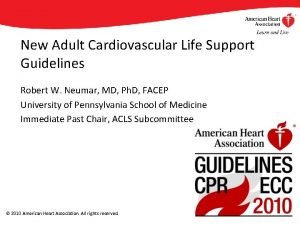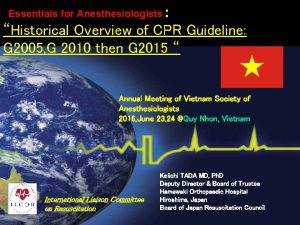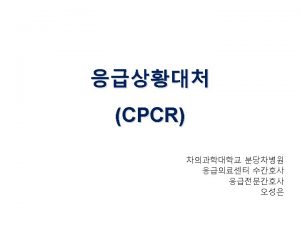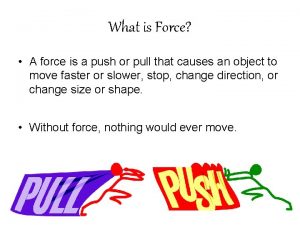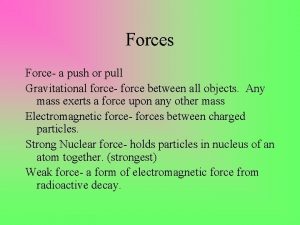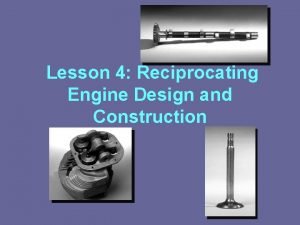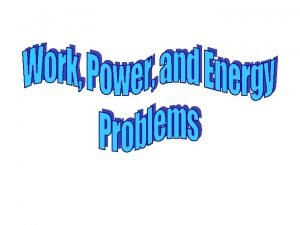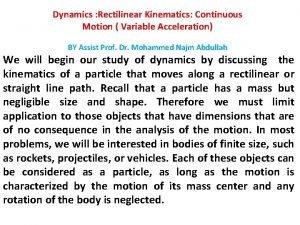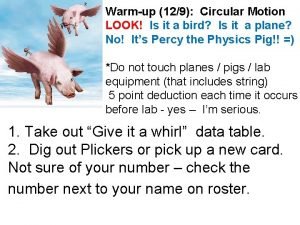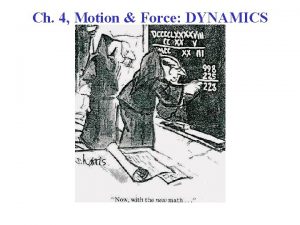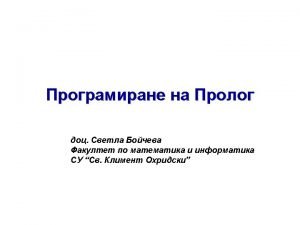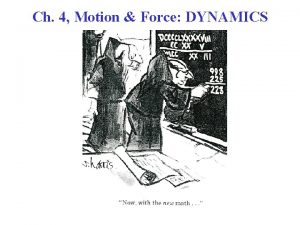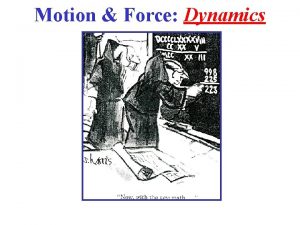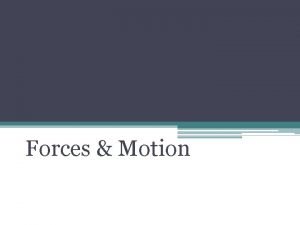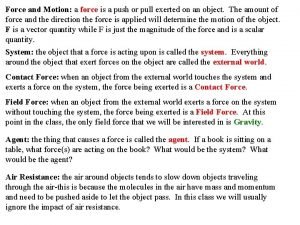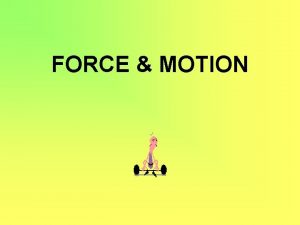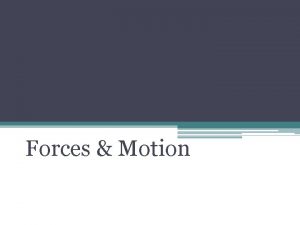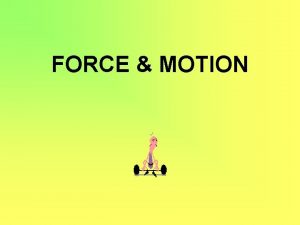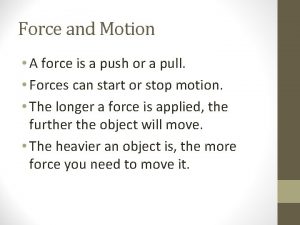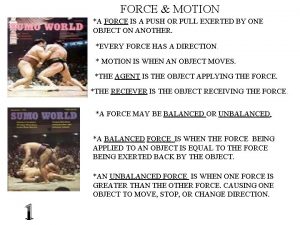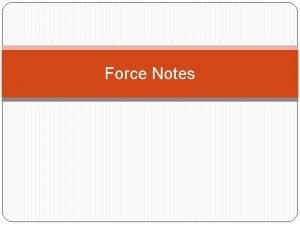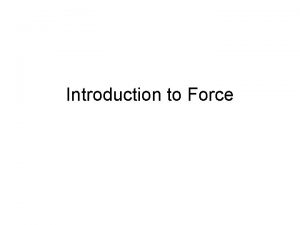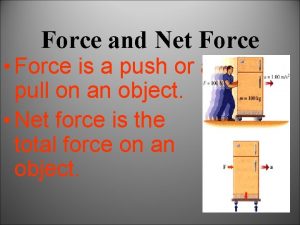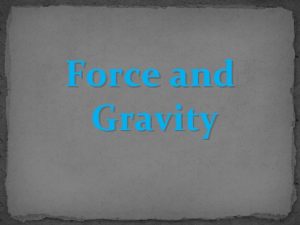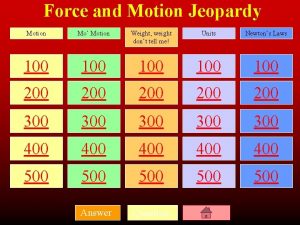Ch 4 Motion Force DYNAMICS Force A push























- Slides: 23

Ch. 4, Motion & Force: DYNAMICS

Force: “A push or a pull”. F is a VECTOR! Vector Addition is needed vector to add Forces!

Classes of Forces “Contact” forces: “Pulling” forces “Field” forces (Physics II): “Pushing” force

Classes of Forces • Contact forces involve physical contact between two objects – Examples (in pictures): spring force, pulling force, pushing force • Field forces act through empty space. – No physical contact is required. – Examples (in pictures): gravitation, electrostatic, magnetic

Fundamental Forces of Nature • Gravitational Forces – Between objects • Electromagnetic Forces – Between electric charges • Nuclear Weak Forces – Arise in certain radioactive decay processes • Nuclear Strong Forces – Between subatomic particles Note: These are all field forces!

Sir Isaac Newton • 1642 – 1727 • Formulated the Basic Laws of Mechanics • Discovered the Law of Universal Gravitation • Invented a form of Calculus • Made many observations dealing with Light and Optics

Newton’s Laws of Motion • The ancient (& wrong!) view (of Aristotle): – A force is needed to keep an object in motion. In the 21 st Century, still a common – The “natural” state of an object is at rest. MISCONCEPTION!!! • The CORRECT VIEW (of Galileo & Newton): – It’s just as natural for an object to be in motion at constant speed in a straight line as to be at rest. Proven by Galileo in the 1620’s! – At first, imagine the case of NO FRICTION Experiment: If NO NET FORCE is applied to an object moving at a constant speed in straight line, it will continue moving at the same speed in a straight line! – If I succeed in having you overcome the wrong, ancient misconception & understand the correct view, one of the main goals of the course will have been achieved!

Newton’s Laws • Galileo laid the ground work for Newton’s Laws. • Newton: Built on Galileo’s work • Newton’s 3 Laws: One at a time

Newton’s First Law Newton was born the same year Galileo died! • Newton’s First Law (“Law of Inertia”): “Every object continues in a state of rest or uniform motion (constant velocity) in a straight line unless acted on by a NET FORCE. ”

Newton’s First Law of Motion Inertial Reference Frames Newton’s 1 st law doesn’t hold in every reference frame, such as a reference frame that is accelerating or rotating. An inertial reference frame is one in which Newton’s first law is valid. Excludes rotating & accelerating frames. How can we tell if we are in an inertial reference frame? By checking to see if Newton’s first law holds!

• Newton’s 1 st Law: First stated by Galileo!

Newton’s First Law A Mathematical Statement of Newton’s 1 st Law: If v = constant, ∑F = 0 OR if v ≠ constant, ∑F ≠ 0

Conceptual Example 4 -1 Newton’s First Law. A school bus comes to a sudden stop, and all of the backpacks on the floor start to slide forward. What force causes them to do that?

Newton’s First Law Alternative Statement • In the absence of external forces, when viewed from an inertial reference frame, an object at rest remains at rest & an object in motion continues in motion with a constant velocity. – Newton’s 1 st Law describes what happens in the absence of a net force. – It also tells us that when no force acts on an object, the acceleration of the object is zero.

Inertia & Mass • Inertia The tendency of an object to maintain its state of rest or motion. • MASS: A measure of the inertia of an object – Quantity of matter in a body – Quantify mass by having a standard mass = Standard Kilogram (kg) (Similar to standards for length & time). – SI Unit of Mass = Kilogram (kg) • cgs unit = gram (g) = 10 -3 kg • Weight: (NOT the same as mass!) – The force of gravity on an object (later in the chapter).

Newton’s Second Law (Lab) • 1 st Law: If no net force acts on it, an object remains at rest or in uniform motion in straight line. • What if a net force does act? Do Experiments. • Find, if the net force ∑F 0 The velocity v changes (in magnitude, in direction or both). • A change in the velocity v (Δv) There is an acceleration a = (Δv/Δt) OR A net force acting on a body produces an acceleration! ∑F a

• Experiment: The net force ∑F on a body and the acceleration a of that body are related. • HOW? Answer by EXPERIMENTS! – Thousands of experiments over hundreds of years find (for an object of mass m): a ∑F/m (proportionality) • We choose the units of force so that this is not just a proportionality but an equation: a ∑F/m OR: (total!) ∑F = ma

• Newton’s 2 nd Law: ∑F = ma ∑F = the net (TOTAL!) force acting on mass m m = the mass (inertia) of the object. a = acceleration of the object. effect of ∑F ∑F is the cause of a. a is a description of the • To emphasize that the F in Newton’s 2 nd Law is the TOTAL (net) force on the mass m, your text writes: ∑F = ma Vector Sum of all Forces! ∑ = a math symbol meaning sum (capital sigma)

• Newton’s 2 nd Law: ∑F = ma Based on experiment! Not derivable mathematically!! A VECTOR equation!! Holds component by component. ∑Fx = max, ∑Fy = may, ∑Fz = maz ONE OF THE MOST FUNDAMENTAL & IMPORTANT LAWS OF CLASSICAL PHYSICS!!!

Summary Newton’s 2 nd law is the relation between acceleration & force. Acceleration is proportional to force and inversely proportional to mass. It takes a force to change either the direction of motion or the speed of an object. More force means more acceleration; the same force exerted on a more massive object will yield less acceleration.

Now, a more precise definition of force: Force = an action capable of accelerating an object. Force is a vector & is true along each coordinate axis. The SI unit of force is the Newton (N) ∑F = ma, unit = kg m/s 2 1 N = 1 kg m/s 2 Note The pound is a unit of force, not of mass, & can therefore be equated to Newtons but not to kilograms.

Laws or Definitions • When is an equation a “Law” & when is it just an equation? • Compare: The one dimensional, constant acceleration kinematic equations: v = v 0 + at, x = x 0 + v 0 t + (½)at 2 NOT Laws! v 2 = (v 0)2 + 2 a (x - x 0) Nothing general or profound. Constant a in one dimension only. Obtained from the definitions of a & v! • With: ∑F = ma Based on EXPERIMENT. NOT derived mathematically from any other expression! Has profound physical content! Very general. A LAW!! Based on experiment! Not on math!! – Or definition of force!

Examples Example 4 -2: Estimate the net force needed to accelerate (a) a 1000 -kg car at (½)g (b) a 200 -g apple at the same rate. Example 4 -3: Force to stop a car. What average net force is required to bring a 1500 -kg car to rest from a speed of 100 km/h (27. 8 m/s) within a distance of 55 m?
 Push hard push fast fully recoil
Push hard push fast fully recoil Push hard push fast fully recoil
Push hard push fast fully recoil Push hard push fast fully recoil
Push hard push fast fully recoil Components of high quality cpr
Components of high quality cpr Shamiel salie
Shamiel salie Mild foreign-body airway obstruction
Mild foreign-body airway obstruction Magnetic force push or pull
Magnetic force push or pull Is gravitational force a push or pull
Is gravitational force a push or pull Technology push force
Technology push force Multiple valve springs are used primarily to
Multiple valve springs are used primarily to Amy uses 20 n of force to push a lawn mower 10 meters
Amy uses 20 n of force to push a lawn mower 10 meters Market pull definition
Market pull definition Rectilinear kinematics: continuous motion
Rectilinear kinematics: continuous motion What is continuous motion in dynamics
What is continuous motion in dynamics Dynamics of uniform circular motion
Dynamics of uniform circular motion Formula for centripetal acceleration in circular motion
Formula for centripetal acceleration in circular motion Type of range of motion
Type of range of motion Simple harmonic motion equation of motion
Simple harmonic motion equation of motion An object in motion stays in motion
An object in motion stays in motion Chapter 2 section 1 describing motion answer key
Chapter 2 section 1 describing motion answer key What is acceleration
What is acceleration Section 1 describing motion answer key
Section 1 describing motion answer key Describing motion chapter 1 lesson 1 answer key
Describing motion chapter 1 lesson 1 answer key Section 1 describing motion
Section 1 describing motion

